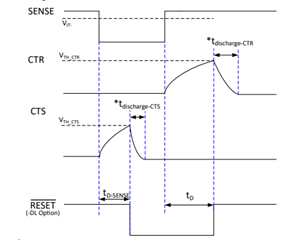Hi,
I want to confirm the behavior on TPS3899.
If the pulse (Low->High->Low) whose width is less than tD (Red circle) enters on SENSE pin, TPS3899 /RESET is Low to High (Yellow arrow), after High to Low on this SENSE pin. Is it correct?
On the case of opposite pulse (High->Low-High), if this pulse width is less than tD enters on SENSE in, TPS3899 /RESET is also High->Low, after Low to High on SENSE pin. Is it correct?
Assume clock which width is less than tD is entered on SENSE pin, /RESET is also output like clock. Is it correct?
Please advise us.
Thanks and best regards,
M.HATTORI.



